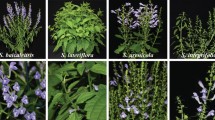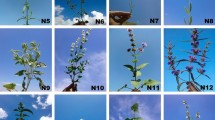Abstract
DIHYDROCHALCONES, which may be regarded as open-chain members of the extensive class of flavonoid compounds with a 15-carbon skeleton, are of limited occurrence in plants. Until recently, the glucosides phloridzin and asebotin were the only well-authenticated examples. Phloridzin was one of the earliest phenolic glucosides to be isolated in a pure state; de Koninck1 reported its presence in apple, pear, plum and cherry trees in 1835, and described its isolation from apple root bark. Its presence in the other fruit trees does not seem to have been confirmed by any other workers; its absence from the pear tree was observed by Rivière and Bailhache in 19042, Bourquelot and Fichtenholz in 19113 and Lincoln in 19264. A survey of a large number of pear species and varieties in the course of the present work has failed to show the presence of even traces of phloridzin in any part of the tree. In fact the work has shown that phloridzin is absent from the leaf of all genera of the sub-family Pomoideae of the Rosaceae other than Malus; and its supposed occurrence in plum5 and cherry has not been confirmed by the examination of many species and varieties of Prunus. It is unfortunate that these erroneous reports of the presence of phloridzin, apparently deriving from de Koninck's original paper of 1835, still persist in many books including some published within the past year.
This is a preview of subscription content, access via your institution
Access options
Subscribe to this journal
Receive 51 print issues and online access
$199.00 per year
only $3.90 per issue
Buy this article
- Purchase on Springer Link
- Instant access to full article PDF
Prices may be subject to local taxes which are calculated during checkout
Similar content being viewed by others
References
de Koninck, L., Annalen, 15, 75, 258 (1835).
Rivière, G., and Bailhache, G., C.R. Acad. Sci., Paris, 139, 81 (1904).
Bourquelot, E., and Fichtenholz, A., C.R. Acad. Sci., Paris, 153, 468 (1911).
Lincoln, F. B., Proc. Amer. Soc. Hort. Sci., 23, 249 (1926).
Harvey, E. M., Amer. J. Bot., 10, 288 (1923).
Rehder, A., Manual of Cultivated Trees and Shrubs, second ed., 389 (The Macmillan Co., New York, 1954).
Williams, A. H., J. Chem. Soc., 4133 (1961).
Eykman, J. F., Rec. Trav. Chim., 2, 99 (1883).
Bourquelot, E., and Fichtenholz, A., C.R. Acad. Sci., Paris, 154, 526 (1912).
Bridel, M., and Kramer, A., C.R. Acad. Sci., Paris, 193, 748 (1931). Murakami, S., and Fukuda, M., J. Pharm. Soc. Japan, 75, 603 (1955).
Rennie, E. H., J. Chem. Soc., 857 (1886).
Iseda, S., Bull. Chem. Soc. Japan, 30, 625 (1957).
Bate-Smith, E. C., and Harborne, J. B., Nature, 198, 1307 (1963).
Goris, A., and Canal, H., C.R. Acad. Sci., Paris, 201, 1435, 1520 (1935).
Nilsson, M., Acta Chem. Scand., 15, 154 (1961).
Williams, A. H., Nature, 175, 213 (1955).
Author information
Authors and Affiliations
Rights and permissions
About this article
Cite this article
WILLIAMS, A. Dihydrochalcones; their Occurrence and Use as Indicators in Chemical Plant Taxonomy. Nature 202, 824–825 (1964). https://doi.org/10.1038/202824b0
Issue Date:
DOI: https://doi.org/10.1038/202824b0
This article is cited by
-
Anti-apoptotic potential of several antidiabetic medicinal plants of the eastern James Bay Cree pharmacopeia in cultured kidney cells
BMC Complementary and Alternative Medicine (2018)
-
Intraspecific flavonoid variation
The Botanical Review (1987)
-
Effect of phloridzin and phloroglucinol on apple shoots
Nature (1976)
Comments
By submitting a comment you agree to abide by our Terms and Community Guidelines. If you find something abusive or that does not comply with our terms or guidelines please flag it as inappropriate.



